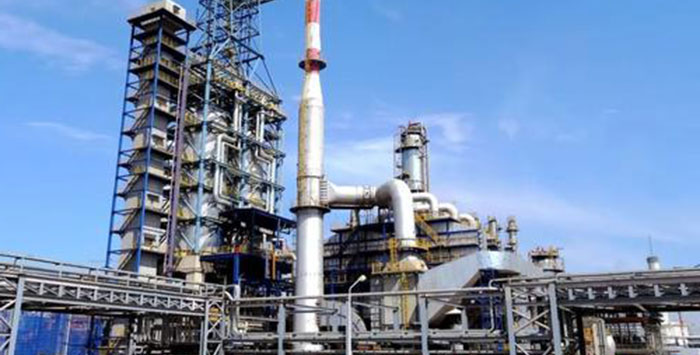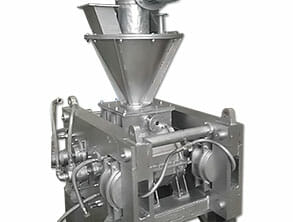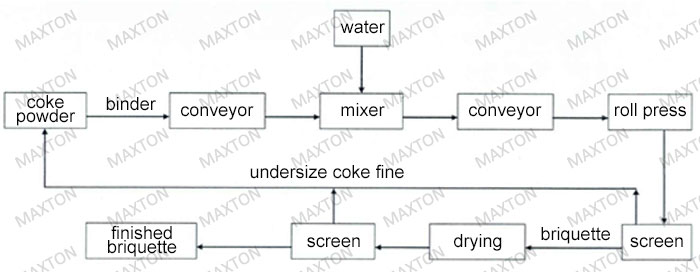Why make coke briquette
Coke powder is a by-product produced by metallurgical calcium carbide and chemical manufacturing enterprises when coke is crushed, transported and used.
Due to the small size of the powder, it does not meet the requirements of production process and is sold cheaply in large quantities, or even directly discarded.
The current price of coke powder is only 1/3 of lump coke, and coke powder can only be used at low value.
Therefore, it is of great significance to use these coke powders to make coke briquette by a binder way to instead of the lump coke in industries. To recycle the waste coke powder not only saves energy, reduces production costs, but also solves serious dust pollution caused by waste coke powder.
How coke fine comes from, the coke powder resources
The production of coke fine mainly comes from two aspects:
- After pyrolysis of raw coal, coke powder with small particle sizes are also produced;
- A by-product that is unavoidably produced in the process of crushing, transportation, production and use of coke in metallurgy, calcium carbide and chemical industries.

Different usage of coke powder
General industrial fuel
Since most companies currently cannot find effective ways to deal with coke powder, it can only be used for general industrial fuels.
Coke powder is often used as a common industrial fuel in the iron ore powder sintering process. Coke powder with suitable particle size can improve the quality of the sinter. Generally, the coke powder is required to have high fixation carbon, low ash content and sulfur, particle size 0-3mm, no requirement on the mechanical strength and ash temperature.
Although use coke powder as a general industrial fuel can solve some problems with recycling coke powder, but there are still problems.
- The coke powder used for sintering is coarse coke powder, and a large amount of too fine coke powder cannot be used;
- The use of coke powder as a common industrial fuel does not require additional technology, but it has no or very low added value.
Production of metallurgical coke
Coke powder is usually used as a thinning agent in the coking process. Appropriate addition of coke powder can improve the quality of coke during the coking process. Due to the increasing shortage of coking coal resources in some places, in order to expand raw material resources and reduce production costs, many coking companies want to use coke powder as a coal blending component for coking to improve the economic benefits of the powder.
Used to make activated carbon
Activated carbon is a kind of carbon material with an extremely developed microporous structure and strong adsorption capacity. It is widely used in various fields such as the chemical industry, food processing, military protection and environmental protection industry. Its characteristics are related to the specific surface area, micropore volume, pore size distribution and chemical composition, and different characteristics are affected by the restriction of the production of raw materials and the preparation method.
Coke powder is a by-product of the coking industry. It has high fixed carbon content, low volatile and ash content, and high strength. It is the best alternative raw material for preparing activated carbon.
Because the coke powder is a product obtained after the dry distillation of raw coal, it can be directly activated to prepare activated carbon, eliminating the need for carbonization steps for preparing activated carbon, which not only reduces energy consumption and production costs but also improves the economic benefits for the manufacturers.
Currently there are mainly two ways to turn coke powder to activated carbon – physical activation and chemical activation.
Physical activation requires raw materials to be carbonized before they can be activated. The activation is carried out at 600-1200 Celsius. The activator includes CO2, water vapor and other oxidizing gases. The oxidizing nature of the gas can oxidize the carbon atoms inside the carbon material. Activated carbon with well-developed pores is formed by expanding and creating new pores.
Chemical activation is to mix the raw material with the activator alkali metal and alkali metal oxychloride, inorganic salt and some acids in a certain proportion. After the mixed raw material is impregnated for a certain period of time, it undergoes a step of carbonization and activation.
An ingredient for coke briquette
The coke powder has no cohesiveness. In order to improve the briquetting performance of the coke powder, it is necessary to add some binders to turn it into briquettes. Normally use carbonaceous materials like semi-coke, coke, charcoal, or raw coal powder as the main raw material, mixed with or without binder, after kneading, mixing, briquetting, and then carbonized to get coke with a certain shape, lumpiness and strength.
Binders for coke briquetting
There are many types of binders can be used for coke briquetting, which can be divided by chemical properties.
- Inorganic binders, such as clay, bentonite, lime, sodium silicate (water glass), etc.;
- Organic binders, such as water-soluble esters, water-soluble resins, polyvinyl alcohol, molasses, etc.;
- Composite adhesive. It is a mixture of inorganic adhesive and organic adhesive.

Using inorganic materials for coke briquetting, the briquette will have good thermal strength and thermal stability, and the price for these types of binders are normally low. However, the coke briquette will have poor waterproof performance, heat generation reduced, and ash content increased.
Using an organic binder for coke briquetting, the briquette will have high cold strength, good waterproof performance, and heat generation will not decrease. However, the thermal stability of the briquette is poor, and normally with a high price, resulting in production costs rise.
In fact, the ratio of various raw materials in the binder is directly related to the strength of the coke powder made into coke. The requirements for the quality of briquetted coke varied with its applications. Generally, the coke briquette must have high strength, heat resistance and water resistance.
Now, some of the researchers are conducted on the ratio of raw coke, some are conducted on the selection, ratio and modification of binders. Most of the produced coke briquettes are used as foundry coke and blast furnace coke. electric furnace coke or ferroalloy coke, etc.
Coking coal briquette making technology
The coal powder/fine briquetting can be divided into cold briquette and hot briquetting, both of which are composed of coal powder briquetting and finished briquette processing.
Cold briquetting is briquetting the coal powder at a temperature lower than its plastic state. It can be divided into two types: binder free process and binder process.
Binder free process is suitable for coal peat and soft lignite. The pressure required is quite high. Briquetting with binder is suitable for coals like anthracite, lignite/brown coal dry distillation charcoal, coke powder, etc. The pressure required on briquetting would be varied from different requirements.
Hot briquetting is to quickly heat the binder and coal powder to a temperature in the plastic state and then briquette the mixture by a hot roll briquette press. The hot briquetting can also be divided into two types.

- Gas heat carrier hot briquetting. Using hot exhaust gas as a heating medium.
- Solid heat carrier hot briquetting. Use high temperature solid semi-coke, anthracite, mineral powder, etc. as the heating medium.
Coke powder briquetting process
A typical coke briquetting process is shown as follow:

- The coke powder is quantitatively fed into the horizontal double-shaft mixer through the feeder, and the prepared binder is quantitatively sprayed into the continuously stirred coke powder through the conveying pump and conveying pipeline;
- During the mixing process in the mixer, water is continuously injected through another pipe to ensure the moisture content of the raw materials. After minutes of mixing, the uniform mixed raw materials are sent to the roll press through the pre-compression screw;
- The uniform mixed raw materials are briquette by the roll briquette machine, briquettes then sieved, and the undersize materials are returned to the feeding silo. Suitable size briquettes are sent to the drying machine by a conveyor to remove free water and be dried there. The finished briquette will be get after drying.
Core equipment in coke powder briquetting system
Mixer
The mixer is a crucial equipment in the production of briquettes, just like the throat for humans. It makes the system run smoothly and affects the strength of the briquette. When selecting equipment for many compressed pellet production lines, only equal mixing of If the consideration of selecting the mixer is only based on its capacity, many problems will be caused, like mixing effect, quantitive feeding, etc.
The mixer can be divided into the batch type and continuous type.
When choosing a mixer, there is some advice.
- Choose continuous type if it is a big briquette plant.
- Choose suitable type by the space required.
- Intensive mixing is required as it can make uniform binder distribution, thus reduce binder cost and improve the briquette quality.
Find an intensive mixer from Maxton.
Briquette machine
The coke fine briquette machine is the key equipment in the production of coke briquette system, and the actual capacity of briquettes produced by the production line is determined by it.
How to find the actual capacity of the coke briquette machine
Capacity=Pocket numbers*each briquette weight*RPM of the roll*6.
On the premise of the same specification, the size of the pocket determines the capacity of the machine, size increases and the capacity increases.
Since the briquette machine is the most important equipment on the coke briquetting plant, it needs to be selected according to the characteristics of the raw materials, the matching of the raw materials and the binder, the strength of the briquette, and the investment budget to select different models with different pressures and configurations.
Main briquetting process conditions
Briquettin preussure
Increasing the briquetting pressure can reduce the porosity of the briquette, thereby increasing the density of the briquette and increasing the contact surface area between the raw material particles. This can strengthen the bite force between the solid material particles, increase the friction between the particles, and briquette strength. And can also increase the molecular bonding force between the raw material and the binder, which can strengthen the bonding effect and ultimately increase the strength of the briquette. It is the main factor affecting the briquetting effect.
Briquetting moisture
Briquetting moisture has an important influence on briquetting the raw materials, mainly because the raw material particles will be rearranged under the pressure. When a certain amount of moisture is added, the moisture will fill the gaps between particles when the particles are arranged, and reduce the friction between the particles. Which makes the particle displacement more likely to cause the particles to be more compact;
Besides, water can play a lubricating effect between the raw material and the roll, reducing the pressure loss caused by friction. Water molecules wrap the particles, forming adsorbed water and film water on the surface of the particles, which will produce molecules binding force, the capillary water filled in the pores of the particles will produce capillary force, and the binding force and capillary force are beneficial to the better briquetting performance of coke powder.
Suitable moisture plays an important role in the briquetting of different materials.
When the moisture of the raw material is too low, the raw material cannot be infiltrated, there is air in the gaps among the particles, and there is greater friction between the particles, between the raw material and the roll. The effective pressure on the raw material is reduced, makes small and uniform density coke briquette. Finally the strength of coke briquette is reduced.
When the moisture is too big, the moisture occupies too much between the particles to prevent their close contact, and the capillary force between the gaps cannot play its role , which ultimately leads to a reduction in the strength of the briquette.
